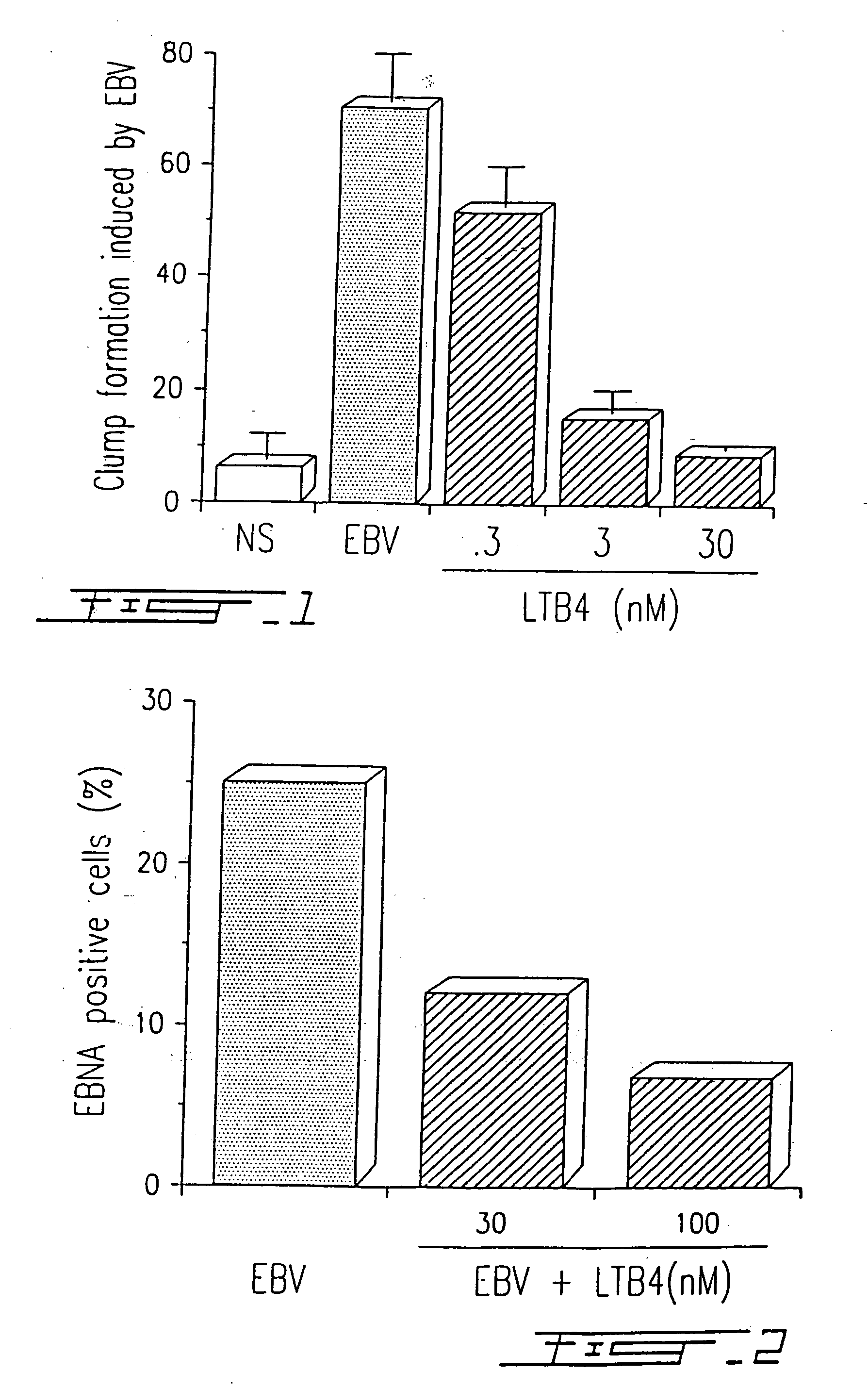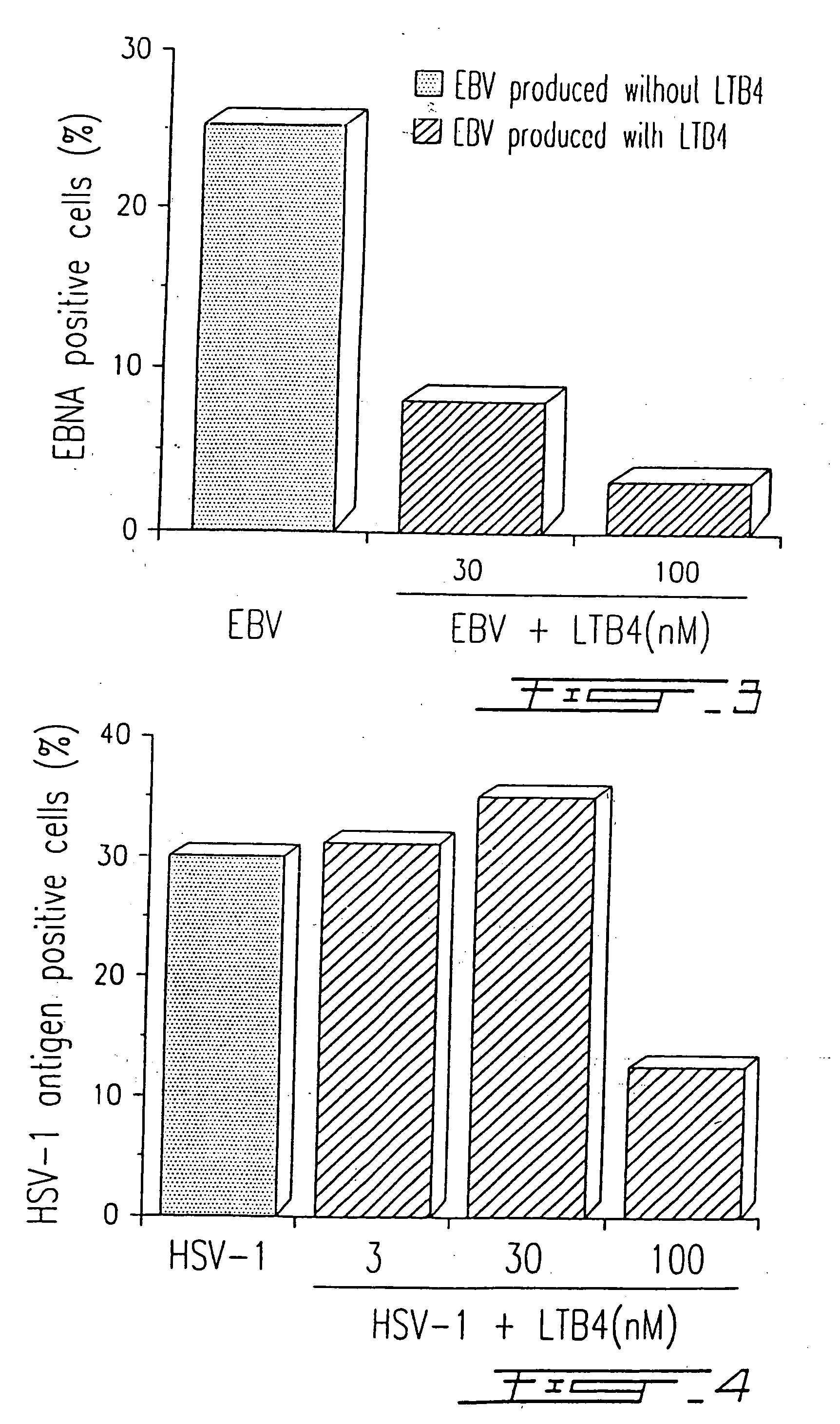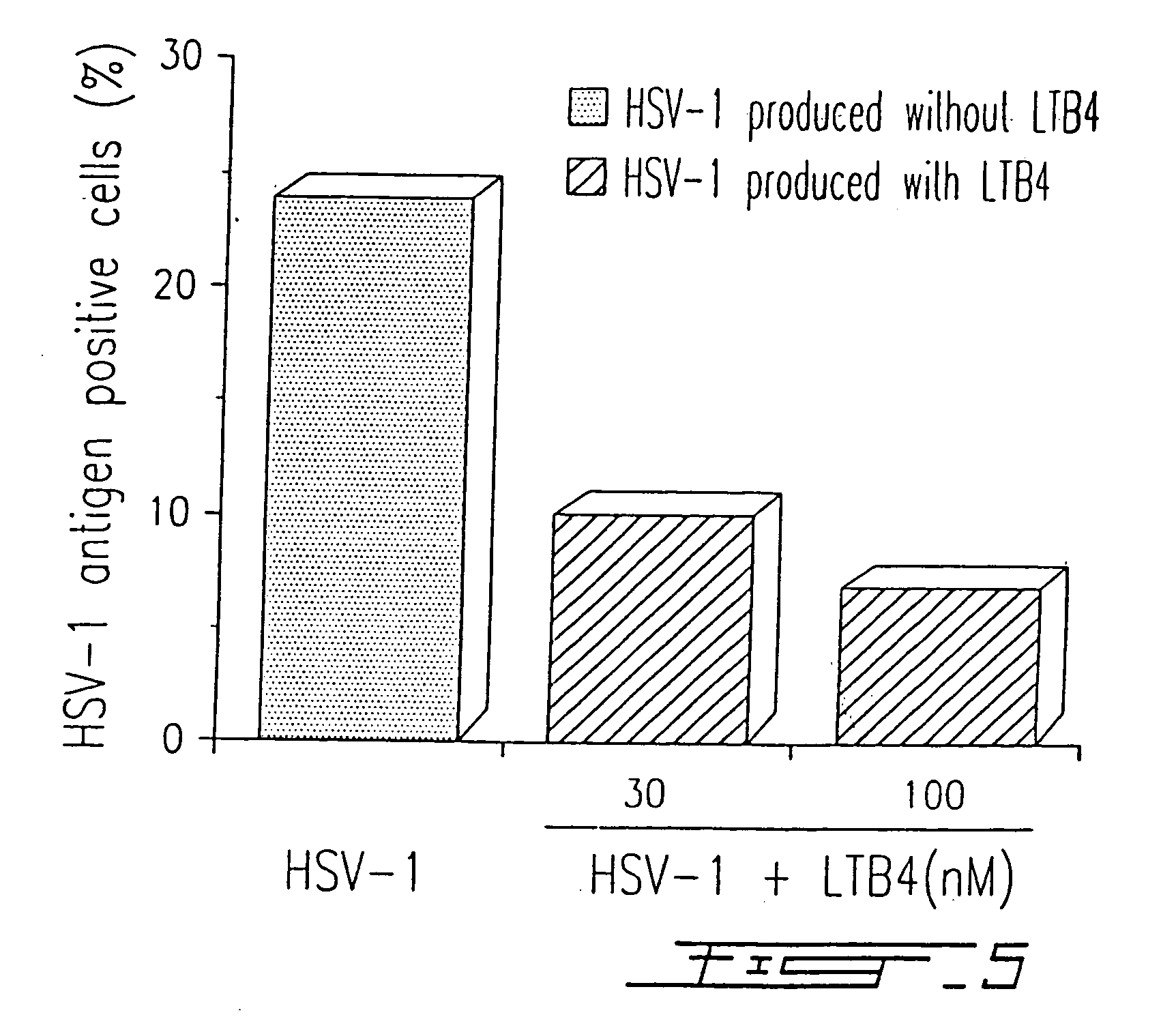Agents with leukotriene B4-like antiviral (enveloped RNA) activities
a technology of antiviral activity and leukotriene b4, which is applied in the field of antiviral activity of leukotriene b4 (ltb4), can solve the problems of limited medical treatment, ineffective treatment of hiv infection, and congenital abnormalities, and achieve the effect of limiting potential side effects and potentiating the antiviral activity of ltb4
- Summary
- Abstract
- Description
- Claims
- Application Information
AI Technical Summary
Benefits of technology
Problems solved by technology
Method used
Image
Examples
example i
Assay for EBV-Induced Clump Formation and EBNA Synthesis in Peripheral Blood Mononuclear Cells
[0078] Clump Formation
[0079] Peripheral blood mononuclear cells (PBMC) were obtained from healthy donors after dextran sedimentation and centrifugation on Ficoll-Paque™ gradients as previously described by Boyum A. (Scand. J. Immunol., 1976, 5(5):9). Cells were resuspended in RPMI-1640 medium supplemented with 10% heat inactivated fetal calf serum (FCS) in the presence of infectious EBV, strain B95-8, at a viral titer of 107 transforming units (TFU) / ml. When indicated, EBV-infected PBMC were simultaneously treated (single addition) with different concentrations of LTB4, i.e. 0.3, 3.0 and 30 nM, respectively. Cells were cultured in 96-well microplates (106 cells / ml at 200 μl / well) during twelve days, and clump formation, which characterizes the EBV-infected cells was evaluated with an inverted microscope (100 X)(FIG. 1).
[0080] Cells were cultured in microplates and the clumps were counted...
example ii
[0085] Assay for HSV-1 Infection of Peripheral Blood Mononuclear Cells
[0086] Detection of Specific HSV-1 Antigen
[0087] PBMC were infected with HSV-1 (strain McIntyre) at a TCID50 of 107 / ml and treated or not with different concentrations of LTB4 (LTB4 was added to the concentrations indicated in FIG. 4 at days 0, 2 and 4) as described in Example I. After five (5) days in culture, the presence of a specific HSV-1 related antigen synthetized in the cytoplasma of infected cells was evaluated by immunofluorescence, using a monoclonal antibody (H62) (ImmunoCorp, Montreal, Canada). Synthesis of the viral antigen was inhibited by 60% in the presence of 100 nM LTB4 (FIG. 4). The results illustrated in FIG. 4 are representative of five (5) other experiments. Similar results (75% inhibition) were obtained by using a specific antiserum (from a chronically infected donor) in immunofluorescence assay.
[0088] Synthesis of HSV-1 Particles
[0089] In order to evaluate the effect of LTB4 on the syn...
example iii
[0097] Effect of LTB4 on EBV-Induced Tumor Formation in Mice
[0098] Assay for EBV Infection in vivo
[0099] The antiviral effect of LTB4 against EBV was evaluated in an in vivo model using C.B.-17 / SCID mice (7-9 week old). Human peripheral blood mononuclear cells (PBL) from healthy donors were obtained by lymphopheresis and purified on Ficoll” gradients. PBL were then washed in PBS and injected intraperitoneally (i.p.) (50×106 cells / 0.5 ml PBS / mouse) to animals. When indicated, mice were infected i.p. with EBV (106 TFU). After 30 minutes, mice were treated with LTB4 (i.p.) (10 μg / 50 μl NaCl:glucose+0.1% BSA). Additional injections of LTB4 were performed on days 1, 6, 8 (10 μg / mouse), and on days 13, 16, 19, 23, 27, 36 and 40 (5 μg / mouse) post-infection. Four groups of SCID mice were constituted as follows: [0100] Group 1: treated with NaCl:glucose+0.1% BSA (5 mice) (placebo) [0101] Group 2: treated with LTB4 (5 mice) [0102] Group 3: EBV-infected and treated with NaCl:glucose+0.1% BSA...
PUM
| Property | Measurement | Unit |
|---|---|---|
| Electric charge | aaaaa | aaaaa |
| Electrical conductance | aaaaa | aaaaa |
| Immunostimulation | aaaaa | aaaaa |
Abstract
Description
Claims
Application Information
 Login to View More
Login to View More - R&D
- Intellectual Property
- Life Sciences
- Materials
- Tech Scout
- Unparalleled Data Quality
- Higher Quality Content
- 60% Fewer Hallucinations
Browse by: Latest US Patents, China's latest patents, Technical Efficacy Thesaurus, Application Domain, Technology Topic, Popular Technical Reports.
© 2025 PatSnap. All rights reserved.Legal|Privacy policy|Modern Slavery Act Transparency Statement|Sitemap|About US| Contact US: help@patsnap.com



